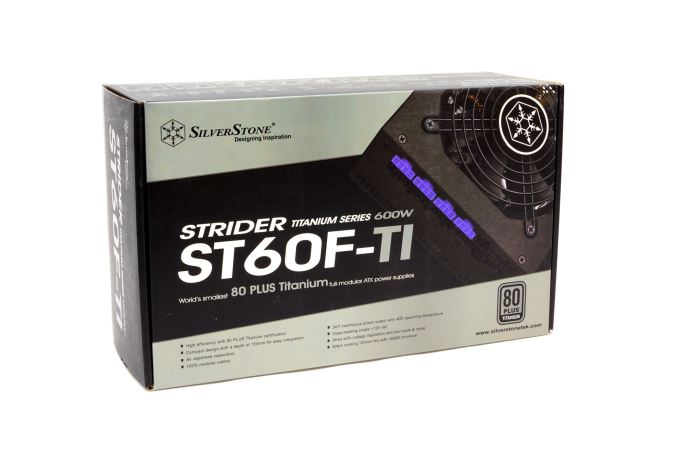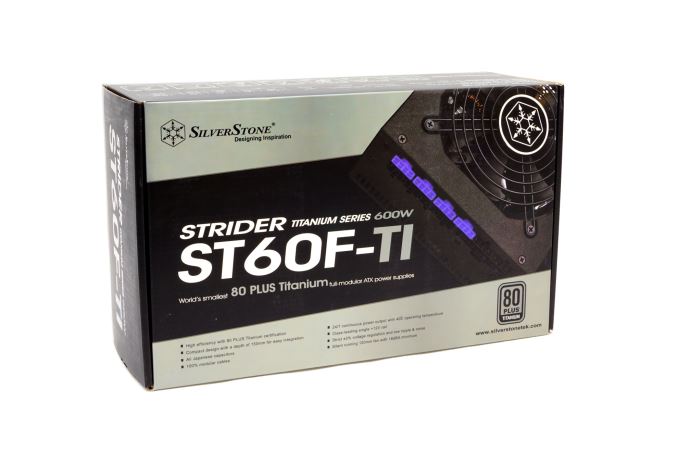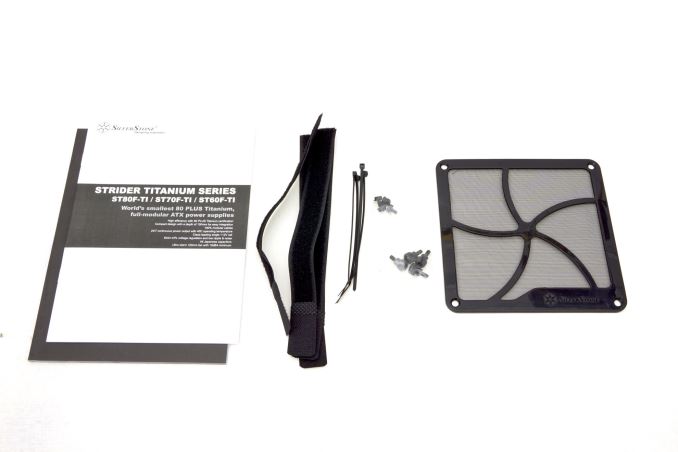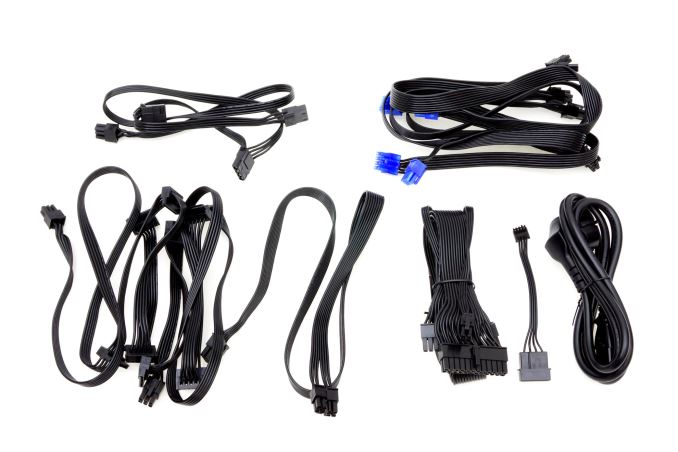The SilverStone ST60F-TI Strider Titanium 600W PSU Review
by E. Fylladitakis on July 29, 2016 8:00 AM EST- Posted in
- PSUs
- Cases/Cooling/PSUs
- SilverStone
- 600W
- 80Plus Titanium

SilverStone is a reputable manufacturer of PC components, strongly focused on the development and marketing of small form factor and proprietary systems. A very large portion of the company’s computer case at retail consists of small form factor and proprietary designs, and cases that frequently can support ATX power supplies in these form factors. SilverStone also markets its PSUs, and is currently offering dozens of them via five different main series.
Introduction
One of SilverStone’s main PSU series is the Strider series, with the main notion of which is to offer high performance ATX PSUs of minimal proportions. Specifically, the company is trying to minimize the length of their units, as the other two dimensions need to remain the same in order to maintain ATX compliance. We recently had a look at the Strider ST55F-PT 550W PSU, an 80Plus Platinum certified PSU that SilverStone is using to specifically target gamers and advanced users building compact systems. 80Plus Platinum efficiency should nowadays be more than enough for even the most demanding of users, but there are those who are willing to pay extra just to get the pinnacle that the technology can currently offer. SilverStone is obviously aware of this, and has recently expanded the Strider Series by inserting 80Plus Titanium certified units into it. In this review we are having a look one of the three new units of that series, the Strider Titanium ST60F-TI 600W PSU.
| Power specifications ( Rated @ 40 °C ) | |||||
| AC INPUT | 100 - 240 VAC, 50 - 60 Hz | ||||
| RAIL | +3.3V | +5V | +12V | +5Vsb | -12V |
| MAX OUTPUT | 20A | 20A | 49A | 2.5A | 0.3A |
| 100W | 588W | 12.5W | 3.6W | ||
| TOTAL | 600W | ||||
Packaging and Bundle
We received the Strider Titanium PSU inside a large and very sturdy cardboard box. Inside the box, the PSU is protected by two thick polyethylene foam pieces and a nylon bag, as well as extra cardboard walls. This is about the maximum level of reasonable shipping protection that one could design. Aesthetically, the theme is simplistic and serious, focused mainly around the model number of the PSU itself. The main features of the PSU are printed on the front side of the box, while more specific details can be found on its sides and rear.
SilverStone supplies a fairly rich bundle alongside with the new Strider Titanium series units. Inside the box we found a standard AC power cable, four black mounting screws and four black thumbscrews, a few cable ties, four long cable straps, a magnetic filter for its fan (or another 120 mm fan), and a well written manual.
The modular cables of the Strider Titanium are "flat" type, ribbon cables, including the main 24-pin ATX cable. All of the wires and connectors are black, with the sole exception being the PSU side connectors of the PCI Express cables, which are blue.
| SilverStone Strider ST60F-TI | ||
| Connector type | Hardwired | Modular |
| ATX 24 Pin | - | 1 |
| EPS 4+4 Pin | - | 1 |
| EPS 8 Pin | - | - |
| PCI-E 6+2 Pin | - | 2 |
| PCI-E 8 Pin | - | 2 |
| SATA | - | 8 |
| Molex | - | 3 |
| Floppy | - | 1 |













21 Comments
View All Comments
Zoeff - Friday, July 29, 2016 - link
I've got this exact PSU for my secondary PC, which is a mini-ITX build. Definitely very quiet and very nice power efficiency!hansmuff - Friday, July 29, 2016 - link
What would be the potential savings in a typical 350-400W enthusiast gaming system compared to a Platinum old Gold PSU? Given this price for a 600W, I have a feeling there is very stiff competition when you compare the bottom line (cost of running a machine.)And that's completely ignoring the filtering issues, which alone for this price would drive me to the Seasonic 660 Platinum.
Freakie - Friday, July 29, 2016 - link
It would take years of 24/7 use at full 600W load to see any monetary savings by going up one or even two 80 PLUS certification tiers. The only reason to get a Gold/Platinum/Titanium is because they tend to be higher quality and the PSU is the most important part of your computer, so high quality is a good thing. Though this thing's Ripple kinda sucks, I definitely wouldn't buy this unit.It's hard to go wrong with Seasonic! I have a 750W Gold Seasonic myself.
Freakie - Friday, July 29, 2016 - link
To further expand. When I'm shopping for a power supply, the order of things I look at is: 1) Rated Wattage 2) Ripple 3) How it behaves in a hot environment 4) Cross-load test results 5) How modular (if it all) the unit is 6) The quality (cable gauge), length, and how many cables it comes with (I like to use Full Tower cases, so short cables wont work, and I tend to have a lot of drives) 7) Price and 8) Literally the last thing I look at is the 80 PLUS rating because there is no way in hell I am going to run a power supply at 100% load (I aim for 60%) and 1%-2% efficiency will make virtually no difference in my power bill. The $30 I save from getting Gold instead of Platinum is more than I am going to realistically save on my power bill.DanNeely - Saturday, July 30, 2016 - link
FYI, with new PSU designs crossload should be irrelevant. Instead of coupled 12 and 5.3/3v supplies modern designs are pure 12V first, and then use DC-DC converters to step down power to the lower voltages as needed.LordanSS - Saturday, July 30, 2016 - link
I'm with you here, I try to keep my intended load in the 50% range as well. Good for noise, good for the PSU's longevity too.Have had motherboards and video cards die in the past because of a poor PSU. A very good quality PSU is a sure thing investment, as they last a very long time anyways.
GeneralTom - Saturday, July 30, 2016 - link
I had a bad Seasonic PSU, Seasonic G-Series G-750.Cables are too short and very stiff.
Alexvrb - Sunday, July 31, 2016 - link
So was it faulty or just cables too short and stiff? Seasonic units are among the best. I buy mainly Seasonic or FSP. And stiff cables, well if the cables are very high quality (heavier gauge) they're going to be stiffer. Cheaper, thinner cables are more flexible. There is a limit though, and sometimes in a tight case you have to give up some wire thickness. But that doesn't mean stiff cables are a "bad" thing, they just have limitations, pros and cons.Freakie - Friday, July 29, 2016 - link
You know what, just for shits and giggles:1% Efficiency difference between Platinum and Titanium
400 W (your load)
12 cents average price per kWh electricity in the USA
.01(1%) x 400(w) = 4(w)
4(w) x 24 (hrs/day) = 96 (w/day)
96(w/day) x 365.25(days/year) = 35,064(w/year)
35,064(w/year) ÷ 1,000 (kWh) = 35.064 (kWh/year)
35.064 (kWh/year) x .12 ($/kWr) = $4.2 savings per year
So you save $4.2 per year if you run it at 400W 24/7 a day, all year long which I doubt you're going to do. There is a 3% efficiency difference between Gold and Titanium so you'd save $12.6 a year if you ran it at 400W 24/7 all year long. Efficiency ratings really aren't worth it.
DanNeely - Saturday, July 30, 2016 - link
At release max efficiency items of any type never pay for themselves in reasonable timeframes in areas of average cost; a situation that's been true all the way back to the original 80+ standard.You're missing two things, the first is that not everyone pays average rates. Move to Hawaii or Germany and you're paying 35-40c/kwh and the max efficiency models will quickly pay for themselves in 24/7 high load situations and generally break even over system lifespans. Move to somewhere in the developing world where the grid isn't reliable and you frequently need to run a generator to keep the lights on and even light usage will make high efficiency units pay for themselves (gas/diesel generators produce stupidly expensive power). Live somewhere hot enough that you run the AC most of the year and rarely need a heater and the fact that every kWH of power your PC consumes is matched by a second for the AC to dissipate it and your real energy costs can be well above the headline numbers. (Live far enough to the north and using it as a space heater reduces the effective cost of energy.)
The other factor you're forgetting is that they all become cheaper over time. When they first came out even the baseline 80+ models had a major price premium attached. Today for conventional use the lifetime breakeven point for an enthusiast system is with a Silver/Gold PSU, or Gold/Platinum under near 24/7 use.
PS A PSU that passes the titanium spec is 2% better than one that passes platinum. This one only got 1% above because it was oversold by Silverstone and didn't meet the spec.
https://en.wikipedia.org/wiki/80_Plus